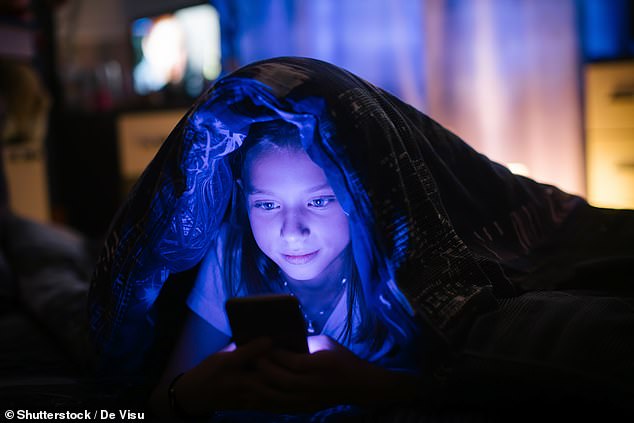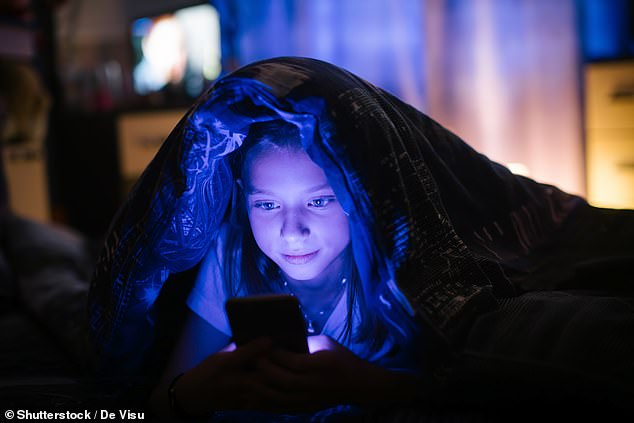A popular nighttime habit could help girls get their periods earlier, experts suggest



A study shows that teens who stare at TV or computers for more than six hours a day enter puberty earlier than teens who have less screen time.
Experts from Gazi University in Turkey exposed rats to six hours of blue light (emitted by screens) or 12 hours, and found that six hours was enough to accelerate growth.
This led to puberty earlier than another group exposed to the same amount of natural light.
Presenting their findings at a conference in Liverpool, the team admitted that their findings were limited to animals, but they said the research could be used to inform ‘preventative measures for safe screen use’ in children.
It comes as experts identify an intriguing trend with more and more girls starting their menstrual cycles earlier than historical averages.
Research shows that children’s screen time increased by as much as 52 percent between 2020 and 2022, likely due to Covid lockdowns.
However, independent British experts have urged people to be cautious about the research, with some even labeling the conclusions as ‘irresponsible’.
They say the type of light used in the study is not comparable to the blue light emitted by TVs, computers and tablets – and that rats’ bodies behave differently from those of humans.

While the team, who presented their findings at a conference in Liverpool, said the study clearly had limitations as it involved animals, but emphasized that their findings had potential implications for humans. Stock image
In the study, the team took 36 baby rats and divided them into three groups.
One cohort was exposed to natural light, while the other two were exposed to six to 12 hours of blue light per day.
Experts then checked the rats, which were evenly split in gender, for the first signs of bone growth and puberty.
They discovered that the blue light group grew faster and therefore entered puberty earlier.
But Professor Pete Etchells, an expert in psychology at Bath Spa University who has studied the impact of screen time, slammed the new research, which has not been published or peer-reviewed.
“This study has nothing to do with screen time or children – it’s a small study on limited blue light exposure in young rats,” he said.
‘So it is simply incorrect to say that “excessive screen time” is associated with early physical development.

Sunlight has a balance between what scientists call red and blue light, and experts are concerned that overexposure to the latter could cause a host of potential negative health problems in the future. Stock image
‘Furthermore, the type and intensity of light exposure used here does not easily translate to the practical reality of how children interact with screen-based technologies.
‘It is therefore not clear to me what this study adds in terms of informing and reassuring the very real concerns that many people have about the potential positive and negative impacts of screen-based technologies.
Another critic was Professor Dorothy Bishop, an expert in developmental neuropsychology at the University of Oxford.
“I urge great caution in drawing conclusions from this study about the impact of light from screens on children,” she said.
She emphasized that the development of rats differs greatly from that of humans, and that the methods used in the study did not reflect the lives of children.
For example, the rats were not given a break to look at the light, which is not consistent with the way children use technology.
However, experts have generally expressed concerns about the potential consequences of chronic blue light exposure.
Earlier this year, scientists from University College London (UCL) warned. it could be a public health ‘time bomb’, potentially leading to its consequences diabetes and even shorten lives.
Sunlight has a balance between what scientists call red and blue light.
Because blue light is naturally visible in daylight when the sun is shining, it naturally increases our attention, reaction speed and mood, essentially making us more awake.
But modern LED lighting and increasing screen use have led to much higher blue light exposure than in previous generations.
Experts who have discovered that excessive blue light can disrupt the functioning of our cells and disrupt our circadian rhythm, the body’s internal clock, leading to a host of negative health consequences.




